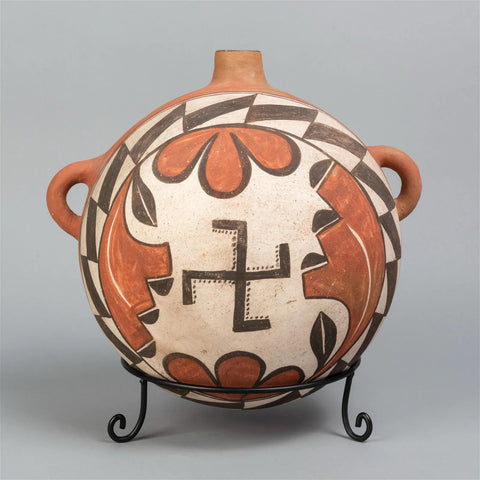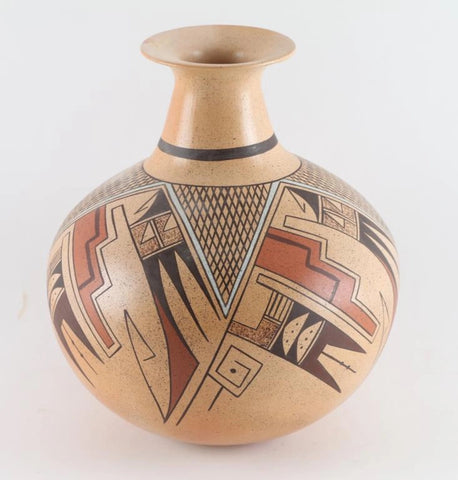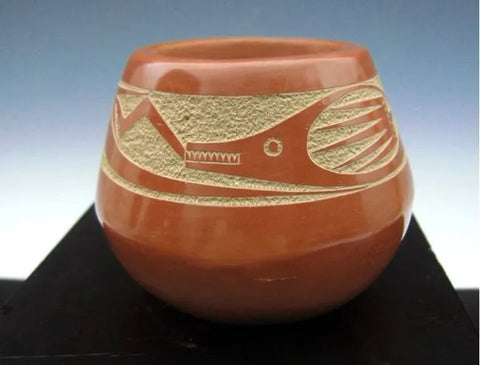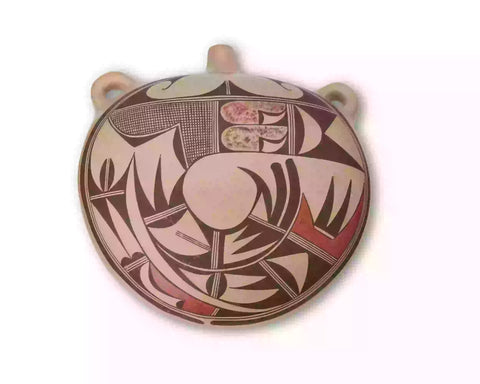
Native American Santo Domingo Pottery Olla, Thomas Tenorio #1192
$ 3,955.00
Native American
Santo Domingo Pottery Olla, Thomas Tenorio #1192
Description: #1192 Native American Santo Domingo Pottery Olla, Thomas Tenorio. large (Santo Domingo) Kewa olla jar decorated with bird and floral design along rim and alternating rows of geometric designs on the shoulder; signed and dated on base Thomas Tenorio 1998;
Dimensions: height 15.75 in. x diameter 15.75 in.
Condition: Very good for age.
Thomas Tenorio
"Thomas Tenorio was given the Indian name of "U-Nah-Thee-Wah" when he was born into the Santo Domingo Pueblo in 1963. Thomas has been making pottery for more than ten years. He felt that the ancient traditional methods of pottery making was dying within his pueblo so he was inspired to try and resurrect the long lived legacy. Thomas taught himself to make traditional pottery by reading textbooks, conducting one on one interviews with other pottery makers, reasearch and trial and error. He now teaches classes on pottery making so anyone wanting to learn the art of working with clay can do so and carry on the tradition. Thomas has invented his own unique contemporary style. He adds contemporary flare of cut-outs and new colors to the traditional Santo Domingo style. He makes a wide variety of shapes and sizes and paints birds and traditional designs with natural pigments found within his pueblo. He signs his pottery: Thomas Tenorio, Santo Domingo Pueblo". (Source: Historic Cameron trading Post)
“Pueblo pottery is made using a coiled technique that came into northern Arizona and New Mexico from the south, some 1500 years ago. In the four-corners region of the US, nineteen pueblos and villages have historically produced pottery. Although each of these pueblos use similar traditional methods of coiling, shaping, finishing and firing, the pottery from each is distinctive. Various clays gathered from each pueblo’s local sources produce pottery colors that range from buff to earthy yellows, oranges, and reds, as well as black. Fired pots are sometimes left plain and other times decorated—most frequently with paint and occasionally with appliqué. Painted designs vary from pueblo to pueblo, yet share an ancient iconography based on abstract representations of clouds, rain, feathers, birds, plants, animals and other natural world features.
Tempering materials and paints, also from natural sources, contribute further to the distinctiveness of each pueblo’s pottery. Some paints are derived from plants, others from minerals. Before firing, potters in some pueblos apply a light colored slip to their pottery, which creates a bright background for painted designs or simply a lighter color plain ware vessel. Designs are painted on before firing, traditionally with a brush fashioned from yucca fiber.
Different combinations of paint color, clay color, and slips are characteristic of different pueblos. Among them are black on cream, black on buff, black on red, dark brown and dark red on white (as found in Zuni pottery), matte red on red, and polychrome—a number of natural colors on one vessel (most typically associated with Hopi). Pueblo potters also produce undecorated polished black ware, black on black ware, and carved red and carved black wares.
Making pueblo pottery is a time-consuming effort that includes gathering and preparing the clay, building and shaping the coiled pot, gathering plants to make the colored dyes, constructing yucca brushes, and, often, making a clay slip. While some Pueblo artists fire in kilns, most still fire in the traditional way in an outside fire pit, covering their vessels with large potsherds and dried sheep dung. Pottery is left to bake for many hours, producing a high-fired result.
Today, Pueblo potters continue to honor this centuries-old tradition of hand-coiled pottery production, yet value the need for contemporary artistic expression as well. They continue to improve their style, methods and designs, often combining traditional and contemporary techniques to create striking new works of art.” (Source: Museum of Northern Arizona)
Santo Domingo Pottery Olla, Thomas Tenorio #1192
Description: #1192 Native American Santo Domingo Pottery Olla, Thomas Tenorio. large (Santo Domingo) Kewa olla jar decorated with bird and floral design along rim and alternating rows of geometric designs on the shoulder; signed and dated on base Thomas Tenorio 1998;
Dimensions: height 15.75 in. x diameter 15.75 in.
Condition: Very good for age.
Thomas Tenorio
"Thomas Tenorio was given the Indian name of "U-Nah-Thee-Wah" when he was born into the Santo Domingo Pueblo in 1963. Thomas has been making pottery for more than ten years. He felt that the ancient traditional methods of pottery making was dying within his pueblo so he was inspired to try and resurrect the long lived legacy. Thomas taught himself to make traditional pottery by reading textbooks, conducting one on one interviews with other pottery makers, reasearch and trial and error. He now teaches classes on pottery making so anyone wanting to learn the art of working with clay can do so and carry on the tradition. Thomas has invented his own unique contemporary style. He adds contemporary flare of cut-outs and new colors to the traditional Santo Domingo style. He makes a wide variety of shapes and sizes and paints birds and traditional designs with natural pigments found within his pueblo. He signs his pottery: Thomas Tenorio, Santo Domingo Pueblo". (Source: Historic Cameron trading Post)
“Pueblo pottery is made using a coiled technique that came into northern Arizona and New Mexico from the south, some 1500 years ago. In the four-corners region of the US, nineteen pueblos and villages have historically produced pottery. Although each of these pueblos use similar traditional methods of coiling, shaping, finishing and firing, the pottery from each is distinctive. Various clays gathered from each pueblo’s local sources produce pottery colors that range from buff to earthy yellows, oranges, and reds, as well as black. Fired pots are sometimes left plain and other times decorated—most frequently with paint and occasionally with appliqué. Painted designs vary from pueblo to pueblo, yet share an ancient iconography based on abstract representations of clouds, rain, feathers, birds, plants, animals and other natural world features.
Tempering materials and paints, also from natural sources, contribute further to the distinctiveness of each pueblo’s pottery. Some paints are derived from plants, others from minerals. Before firing, potters in some pueblos apply a light colored slip to their pottery, which creates a bright background for painted designs or simply a lighter color plain ware vessel. Designs are painted on before firing, traditionally with a brush fashioned from yucca fiber.
Different combinations of paint color, clay color, and slips are characteristic of different pueblos. Among them are black on cream, black on buff, black on red, dark brown and dark red on white (as found in Zuni pottery), matte red on red, and polychrome—a number of natural colors on one vessel (most typically associated with Hopi). Pueblo potters also produce undecorated polished black ware, black on black ware, and carved red and carved black wares.
Making pueblo pottery is a time-consuming effort that includes gathering and preparing the clay, building and shaping the coiled pot, gathering plants to make the colored dyes, constructing yucca brushes, and, often, making a clay slip. While some Pueblo artists fire in kilns, most still fire in the traditional way in an outside fire pit, covering their vessels with large potsherds and dried sheep dung. Pottery is left to bake for many hours, producing a high-fired result.
Today, Pueblo potters continue to honor this centuries-old tradition of hand-coiled pottery production, yet value the need for contemporary artistic expression as well. They continue to improve their style, methods and designs, often combining traditional and contemporary techniques to create striking new works of art.” (Source: Museum of Northern Arizona)
Related Products
Sold out










